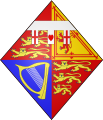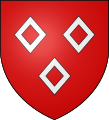The glyph
The lozenge glyph is found in DOS code page 437 (at character code 4)[2] and Mac-Roman. It is found in the Unicode Geometrical Shapes range[3] at U+25CA LOZENGE. In HTML it can be typed with ◊ (or ◊ or ◊), which will produce ◊. The LaTeX command for the lozenge is\lozenge.Modal logic
In modal logic, the lozenge expresses the possibility of the following expression. For example, the expression expresses that it is possible that P is true.
expresses that it is possible that P is true.Mathematics
In axiomatic set theory, the lozenge refers to the principles known collectively as diamondsuit.Camouflage
During the First World War, the Germans were looking for a way to effectively camouflage their aircraft. This resulted in the development of the so-called lozenge pattern[4] (Lozengetarnung), made up of irregularly shaped colored polygons (not necessarily actual rhombi). Because painting such a pattern was very time consuming, and the paint added considerably to the weight of the aircraft, it was decided to print the pattern on fabric. This pre-printed fabric was used from 1916 onwards, in various forms and colours. The most notable of these were the day fighter used variations-the five color version, usually nicknamed "Canberra" from its existence on the Australian War Memorial's Albatros D.Va aircraft, and the four color version, nicknamed "Knowlton" from its existence on the Brome County Historical Society's Fokker D.VII aircraft in the Knowlton suburb of Lac-Brome, Quebec, Canada. Both the Canberra and Knowlton patterns had sets of darker shades of their colors for upper surface application, and lighter shades for underside application.Heraldry
The lozenge in heraldry is a diamond-shaped charge (an object that can be placed on the field of the shield), usually somewhat narrower than it is tall. It is to be distinguished in modern heraldry from the fusil, which is like the lozenge but narrower, though the distinction has not always been as fine and is not always observed even today. A mascle is a voided lozenge-- that is, a lozenge with a lozenge-shaped hole in the middle-- and the rarer rustre is a lozenge containing a circular hole. A field covered in a pattern of lozenges is described as lozengy; similar fields of mascles are masculy, and fusils, fusily.
The lozenge has for many centuries been particularly associated with women as a vehicle for the display of their coats of arms (instead of the escutcheon or shield). In modern English and Scottish, but not Canadian, heraldry, the arms of an unmarried woman and of widows are usually shown on a lozenge rather than an escutcheon, without crest or helm. An oval or cartouche is occasionally also used instead of the lozenge for such women.
Married women, however, always display their arms on a shield (except peeresses in their own right, who use the lozenge for their peerage arms even during marriage).
The shield of a married woman (and the lozenge of a widow) may combine her own arms with the arms of her husband, either by impalement side by side or (in the case of an heraldic heiress in English heraldry, but not Scots) in the form of a small "escutcheon of pretence" displaying the wife's arms over a larger shield (or, in the case of a widow, lozenge) of her husband's arms.
As a result of rulings of the English Kings of Arms dated 7 April 1995 and 6 November 1997, married women in England, Northern Ireland and Wales and in other countries recognising the jurisdiction of the College of Arms in London (such as New Zealand) also have the option of using their husband's arms alone, marked with a small lozenge as a brisure to show that the arms are displayed for the wife and not the husband, or of using their own personal arms alone, marked with a small shield as a brisure for the same reason.
Divorced women may theoretically until remarriage use their ex-husband's arms differenced with a mascle.
The lozenge shape is also used for funereal hatchments for both men and women.
| This Monegasque flag is "lozengy argent and gules" | The personal arms of Anne, Princess Royal displayed on a lozenge. | ||
Cough tablets
A throat lozenge or cough drop is a small, medicated candy intended to be dissolved slowly in the mouth to lubricate and soothe irritated tissues of the throat (usually due to a sore throat), possibly from the common cold or influenza. Cough tablets have taken the name lozenge, based on their original shape.Lozenges may contain benzocaine, an anesthetic, or eucalyptus oil. Non-menthol throat lozenges generally use either zinc gluconate glycine or pectin as an oral demulcent. Several brands of throat lozenges contain dextromethorphan.
Still other varieties[vague] contain little more than menthol or peppermint oil and spearmint as their active ingredient, further blurring the line between candy and coughdrops.
Most throat lozenges should be taken in moderation, due to the fact that some active ingredients could be hazardous to the health if consumed in large amounts.[citation needed]
Because of their antibacterial properties, some throat lozenges can double as breath fresheners, eliminating odor-causing bacteria in the mouth.Cough tablets have taken the name lozenge, based on their original shape. According to the Oxford English Dictionary the first use of this sense was in 1530.
U.S. Military
The lozenge is used in the U.S. Army, Marine Corps, and Air Force on the insignia of their respective First Sergeants.They are also used in the Junior ROTC, for Officers from the military pay grades of O-4 to O-6 (Major/Lieutenant Colonel to Colonel/Captain).
Finnish Defence Forces
In Finnish military ranks, the lozenge is found in the insignia of conscript officer students (one lozenge) and conscript officer cadets (two lozenges).Transportation
The lozenge can be used on public roadways in the United States and Canada to mark a specific lane for a particular use. The lane will usually be painted with a lozenge at a regular interval, and signage will be installed to indicate the restrictions on using the lane. This marking is most often used to denote high-occupancy vehicle lanes, with accompanying signage reading "◊ HOV LANE" and giving the requirements for a vehicle to be accepted as "high-occupancy". Prior to 17 January 2006, lozenges could also be used to mark bicycle-only lanes, often in conjunction with a bicycle icon.[5]








